NZS3910/FIDIC Contracts: Project Management & Variation Analysis
VerifiedAdded on 2023/06/03
|17
|6226
|197
Report
AI Summary
This report critically analyzes the statement regarding variation's impact on quality and agility in construction projects, using examples and literary evidence to validate its claims. It develops a framework defining the project manager's role in expediting project delivery and minimizing variation claims within standard contracts like NZS3910 or FIDIC. The report further examines how procurement and supply chain practices affect a project manager's ability to implement Total Quality Management (TQM) systems and how ethical considerations influence supply chain and procurement choices. Finally, it proposes a redefinition of the project manager's role, either by responsibilities, accountability, or authority, to address these challenges effectively.
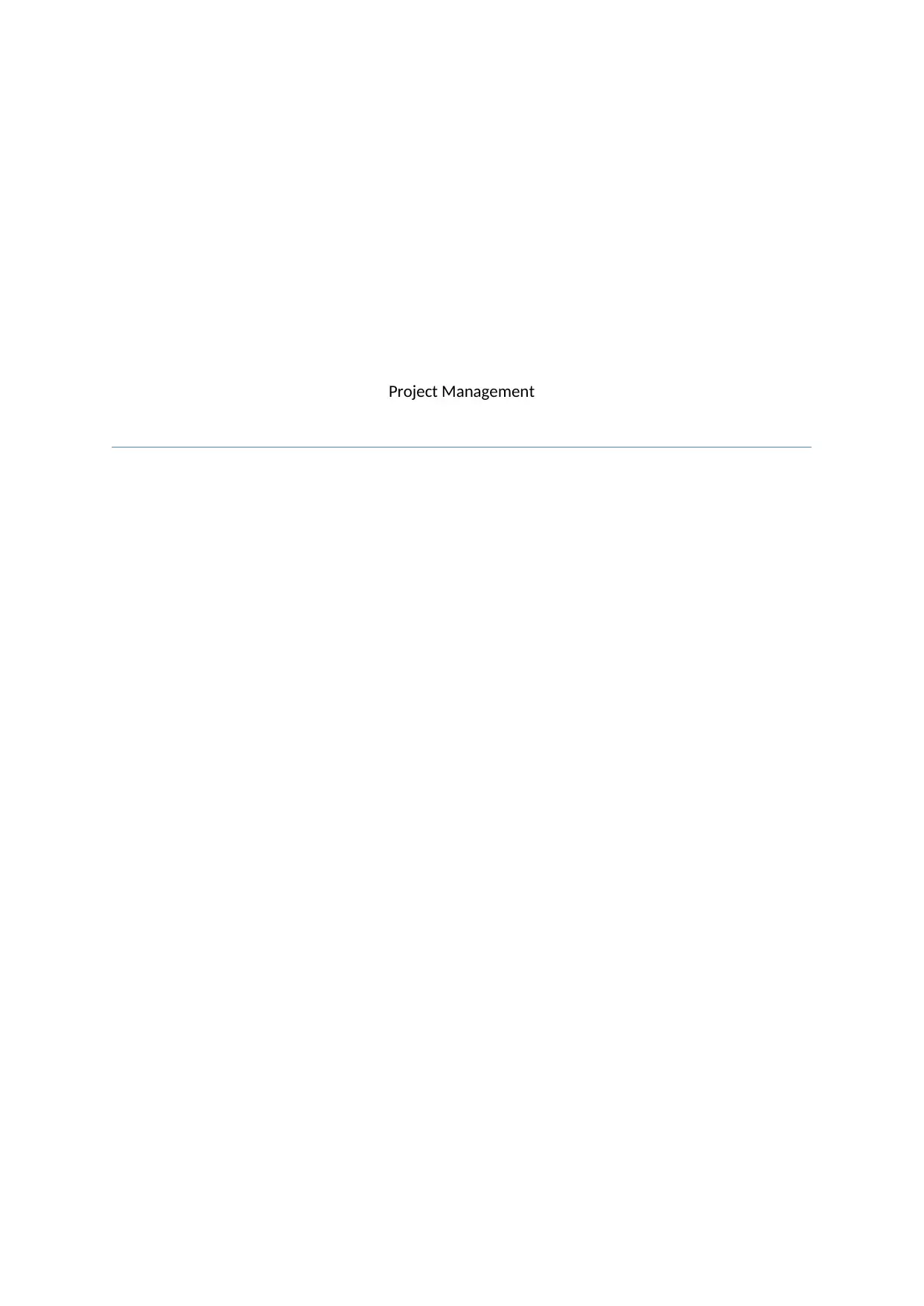
Project Management
Paraphrase This Document
Need a fresh take? Get an instant paraphrase of this document with our AI Paraphraser
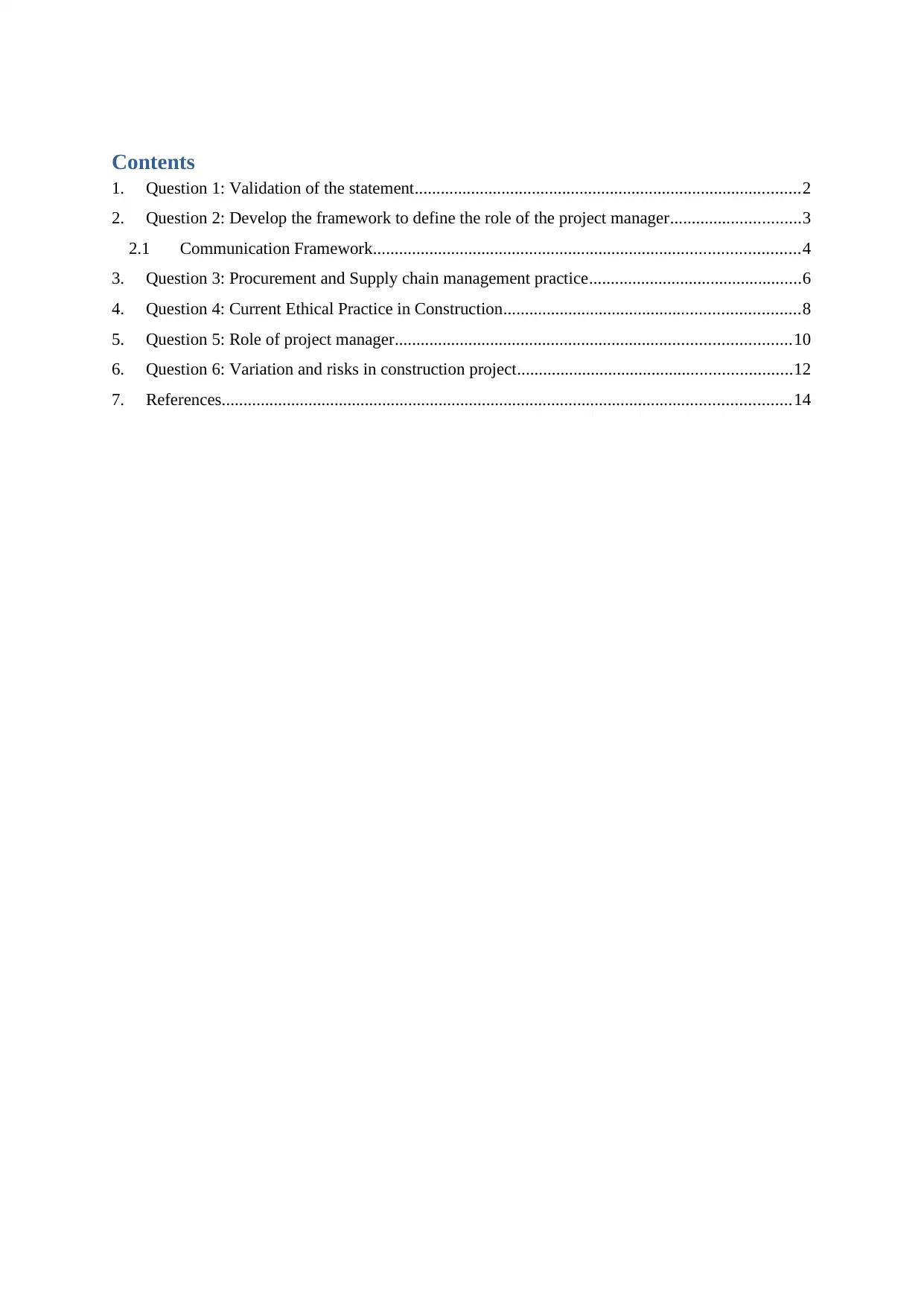
Contents
1. Question 1: Validation of the statement.........................................................................................2
2. Question 2: Develop the framework to define the role of the project manager..............................3
2.1 Communication Framework..................................................................................................4
3. Question 3: Procurement and Supply chain management practice.................................................6
4. Question 4: Current Ethical Practice in Construction....................................................................8
5. Question 5: Role of project manager...........................................................................................10
6. Question 6: Variation and risks in construction project...............................................................12
7. References...................................................................................................................................14
1. Question 1: Validation of the statement.........................................................................................2
2. Question 2: Develop the framework to define the role of the project manager..............................3
2.1 Communication Framework..................................................................................................4
3. Question 3: Procurement and Supply chain management practice.................................................6
4. Question 4: Current Ethical Practice in Construction....................................................................8
5. Question 5: Role of project manager...........................................................................................10
6. Question 6: Variation and risks in construction project...............................................................12
7. References...................................................................................................................................14
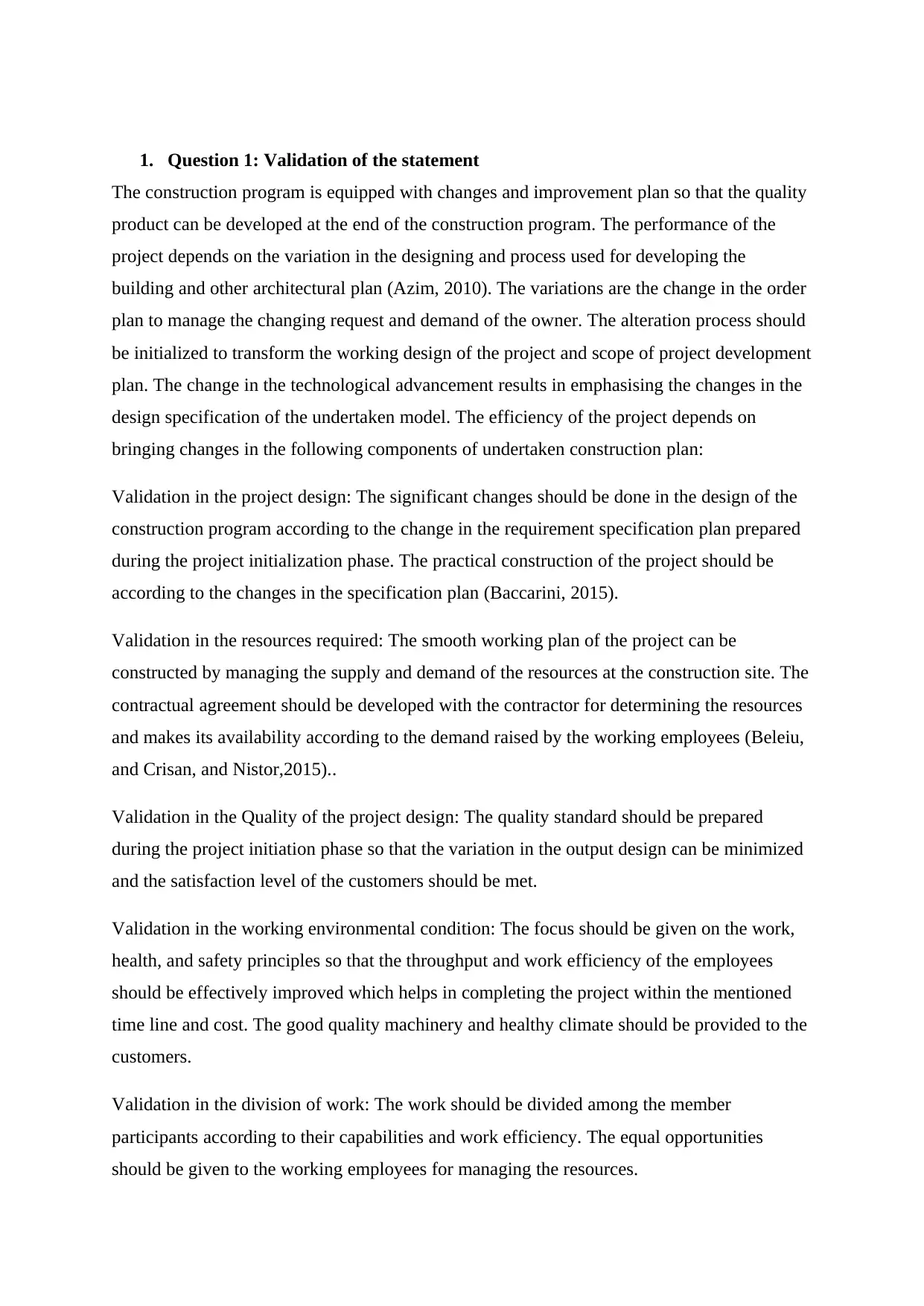
1. Question 1: Validation of the statement
The construction program is equipped with changes and improvement plan so that the quality
product can be developed at the end of the construction program. The performance of the
project depends on the variation in the designing and process used for developing the
building and other architectural plan (Azim, 2010). The variations are the change in the order
plan to manage the changing request and demand of the owner. The alteration process should
be initialized to transform the working design of the project and scope of project development
plan. The change in the technological advancement results in emphasising the changes in the
design specification of the undertaken model. The efficiency of the project depends on
bringing changes in the following components of undertaken construction plan:
Validation in the project design: The significant changes should be done in the design of the
construction program according to the change in the requirement specification plan prepared
during the project initialization phase. The practical construction of the project should be
according to the changes in the specification plan (Baccarini, 2015).
Validation in the resources required: The smooth working plan of the project can be
constructed by managing the supply and demand of the resources at the construction site. The
contractual agreement should be developed with the contractor for determining the resources
and makes its availability according to the demand raised by the working employees (Beleiu,
and Crisan, and Nistor,2015)..
Validation in the Quality of the project design: The quality standard should be prepared
during the project initiation phase so that the variation in the output design can be minimized
and the satisfaction level of the customers should be met.
Validation in the working environmental condition: The focus should be given on the work,
health, and safety principles so that the throughput and work efficiency of the employees
should be effectively improved which helps in completing the project within the mentioned
time line and cost. The good quality machinery and healthy climate should be provided to the
customers.
Validation in the division of work: The work should be divided among the member
participants according to their capabilities and work efficiency. The equal opportunities
should be given to the working employees for managing the resources.
The construction program is equipped with changes and improvement plan so that the quality
product can be developed at the end of the construction program. The performance of the
project depends on the variation in the designing and process used for developing the
building and other architectural plan (Azim, 2010). The variations are the change in the order
plan to manage the changing request and demand of the owner. The alteration process should
be initialized to transform the working design of the project and scope of project development
plan. The change in the technological advancement results in emphasising the changes in the
design specification of the undertaken model. The efficiency of the project depends on
bringing changes in the following components of undertaken construction plan:
Validation in the project design: The significant changes should be done in the design of the
construction program according to the change in the requirement specification plan prepared
during the project initialization phase. The practical construction of the project should be
according to the changes in the specification plan (Baccarini, 2015).
Validation in the resources required: The smooth working plan of the project can be
constructed by managing the supply and demand of the resources at the construction site. The
contractual agreement should be developed with the contractor for determining the resources
and makes its availability according to the demand raised by the working employees (Beleiu,
and Crisan, and Nistor,2015)..
Validation in the Quality of the project design: The quality standard should be prepared
during the project initiation phase so that the variation in the output design can be minimized
and the satisfaction level of the customers should be met.
Validation in the working environmental condition: The focus should be given on the work,
health, and safety principles so that the throughput and work efficiency of the employees
should be effectively improved which helps in completing the project within the mentioned
time line and cost. The good quality machinery and healthy climate should be provided to the
customers.
Validation in the division of work: The work should be divided among the member
participants according to their capabilities and work efficiency. The equal opportunities
should be given to the working employees for managing the resources.
⊘ This is a preview!⊘
Do you want full access?
Subscribe today to unlock all pages.

Trusted by 1+ million students worldwide
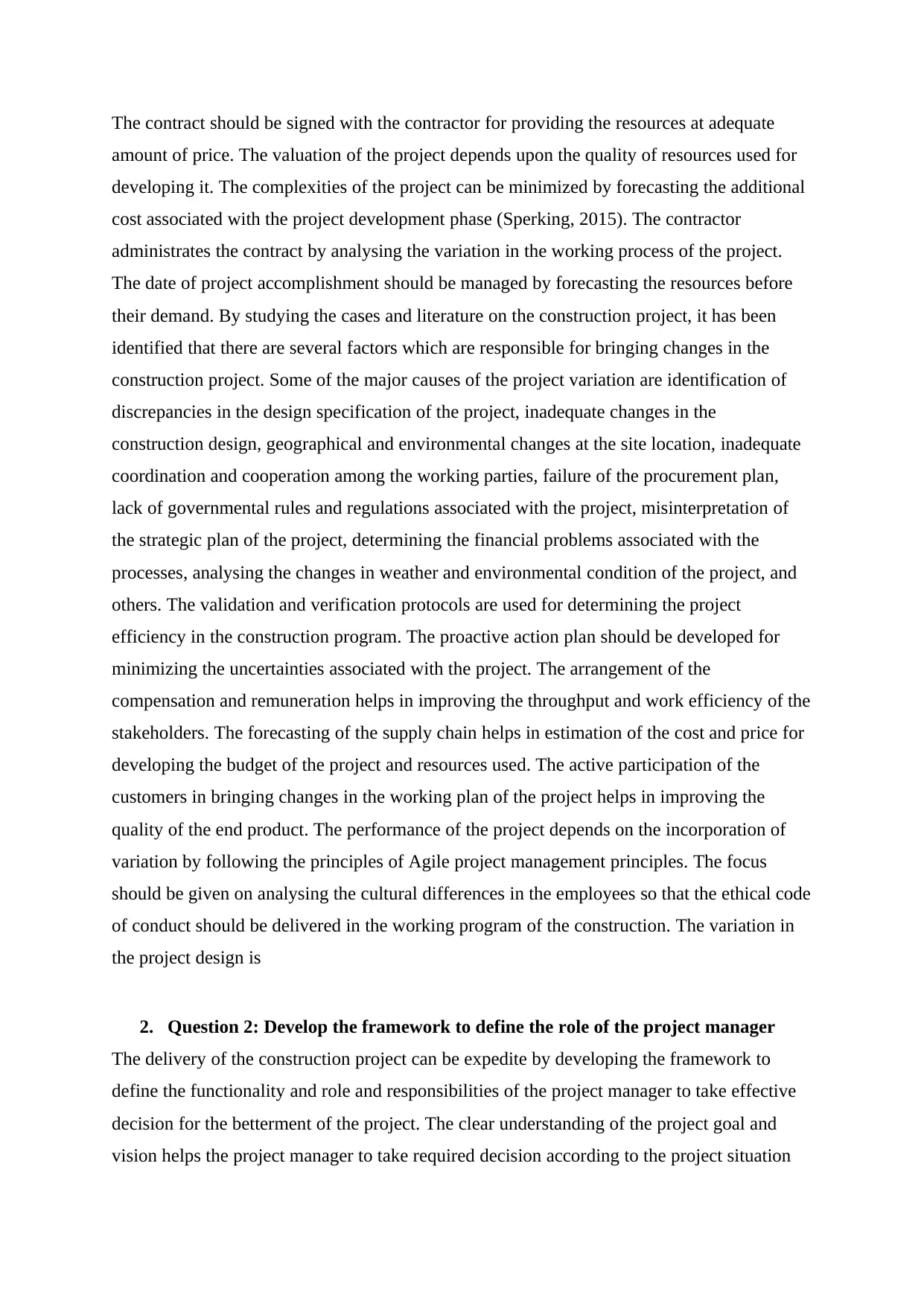
The contract should be signed with the contractor for providing the resources at adequate
amount of price. The valuation of the project depends upon the quality of resources used for
developing it. The complexities of the project can be minimized by forecasting the additional
cost associated with the project development phase (Sperking, 2015). The contractor
administrates the contract by analysing the variation in the working process of the project.
The date of project accomplishment should be managed by forecasting the resources before
their demand. By studying the cases and literature on the construction project, it has been
identified that there are several factors which are responsible for bringing changes in the
construction project. Some of the major causes of the project variation are identification of
discrepancies in the design specification of the project, inadequate changes in the
construction design, geographical and environmental changes at the site location, inadequate
coordination and cooperation among the working parties, failure of the procurement plan,
lack of governmental rules and regulations associated with the project, misinterpretation of
the strategic plan of the project, determining the financial problems associated with the
processes, analysing the changes in weather and environmental condition of the project, and
others. The validation and verification protocols are used for determining the project
efficiency in the construction program. The proactive action plan should be developed for
minimizing the uncertainties associated with the project. The arrangement of the
compensation and remuneration helps in improving the throughput and work efficiency of the
stakeholders. The forecasting of the supply chain helps in estimation of the cost and price for
developing the budget of the project and resources used. The active participation of the
customers in bringing changes in the working plan of the project helps in improving the
quality of the end product. The performance of the project depends on the incorporation of
variation by following the principles of Agile project management principles. The focus
should be given on analysing the cultural differences in the employees so that the ethical code
of conduct should be delivered in the working program of the construction. The variation in
the project design is
2. Question 2: Develop the framework to define the role of the project manager
The delivery of the construction project can be expedite by developing the framework to
define the functionality and role and responsibilities of the project manager to take effective
decision for the betterment of the project. The clear understanding of the project goal and
vision helps the project manager to take required decision according to the project situation
amount of price. The valuation of the project depends upon the quality of resources used for
developing it. The complexities of the project can be minimized by forecasting the additional
cost associated with the project development phase (Sperking, 2015). The contractor
administrates the contract by analysing the variation in the working process of the project.
The date of project accomplishment should be managed by forecasting the resources before
their demand. By studying the cases and literature on the construction project, it has been
identified that there are several factors which are responsible for bringing changes in the
construction project. Some of the major causes of the project variation are identification of
discrepancies in the design specification of the project, inadequate changes in the
construction design, geographical and environmental changes at the site location, inadequate
coordination and cooperation among the working parties, failure of the procurement plan,
lack of governmental rules and regulations associated with the project, misinterpretation of
the strategic plan of the project, determining the financial problems associated with the
processes, analysing the changes in weather and environmental condition of the project, and
others. The validation and verification protocols are used for determining the project
efficiency in the construction program. The proactive action plan should be developed for
minimizing the uncertainties associated with the project. The arrangement of the
compensation and remuneration helps in improving the throughput and work efficiency of the
stakeholders. The forecasting of the supply chain helps in estimation of the cost and price for
developing the budget of the project and resources used. The active participation of the
customers in bringing changes in the working plan of the project helps in improving the
quality of the end product. The performance of the project depends on the incorporation of
variation by following the principles of Agile project management principles. The focus
should be given on analysing the cultural differences in the employees so that the ethical code
of conduct should be delivered in the working program of the construction. The variation in
the project design is
2. Question 2: Develop the framework to define the role of the project manager
The delivery of the construction project can be expedite by developing the framework to
define the functionality and role and responsibilities of the project manager to take effective
decision for the betterment of the project. The clear understanding of the project goal and
vision helps the project manager to take required decision according to the project situation
Paraphrase This Document
Need a fresh take? Get an instant paraphrase of this document with our AI Paraphraser
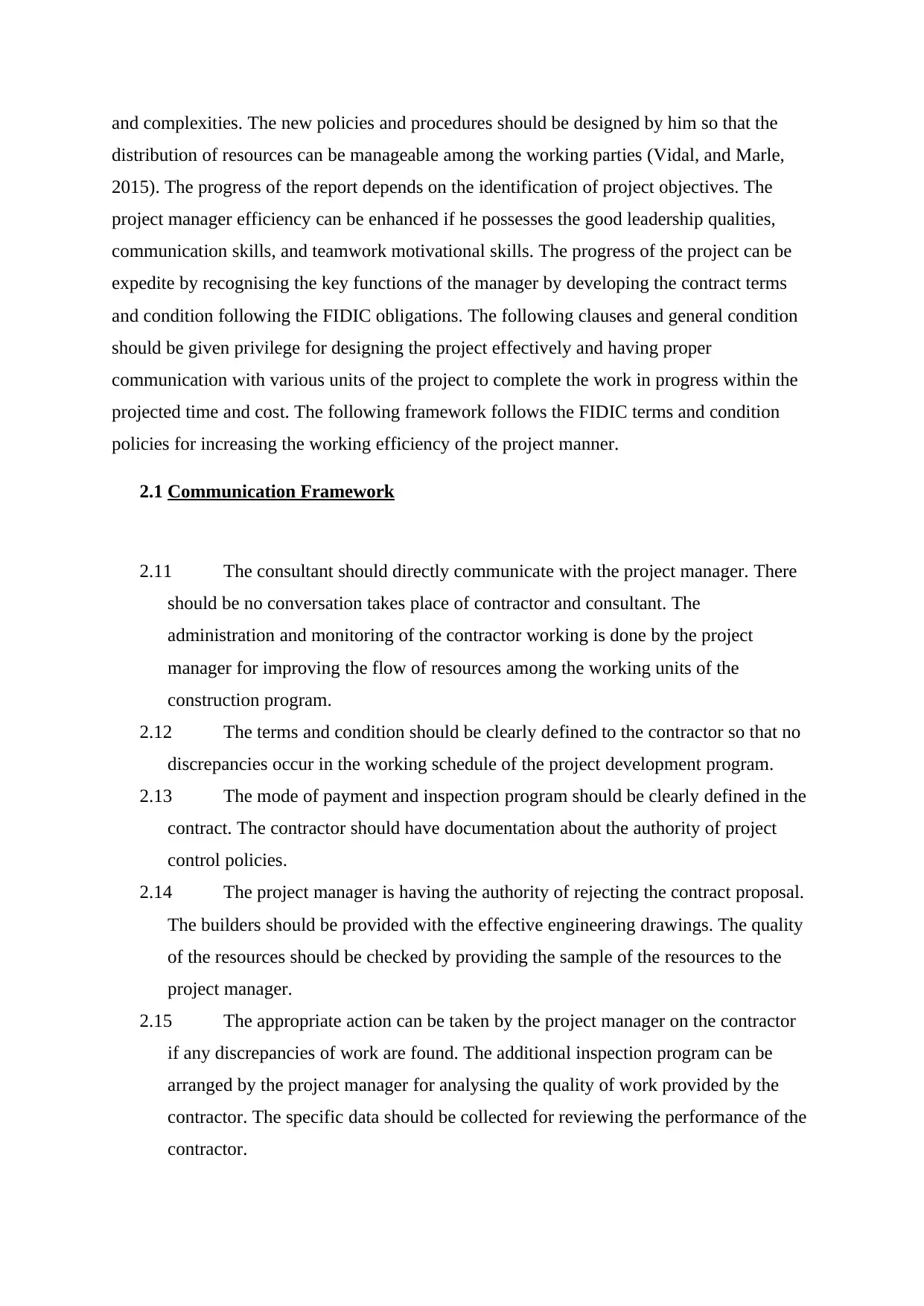
and complexities. The new policies and procedures should be designed by him so that the
distribution of resources can be manageable among the working parties (Vidal, and Marle,
2015). The progress of the report depends on the identification of project objectives. The
project manager efficiency can be enhanced if he possesses the good leadership qualities,
communication skills, and teamwork motivational skills. The progress of the project can be
expedite by recognising the key functions of the manager by developing the contract terms
and condition following the FIDIC obligations. The following clauses and general condition
should be given privilege for designing the project effectively and having proper
communication with various units of the project to complete the work in progress within the
projected time and cost. The following framework follows the FIDIC terms and condition
policies for increasing the working efficiency of the project manner.
2.1 Communication Framework
2.11 The consultant should directly communicate with the project manager. There
should be no conversation takes place of contractor and consultant. The
administration and monitoring of the contractor working is done by the project
manager for improving the flow of resources among the working units of the
construction program.
2.12 The terms and condition should be clearly defined to the contractor so that no
discrepancies occur in the working schedule of the project development program.
2.13 The mode of payment and inspection program should be clearly defined in the
contract. The contractor should have documentation about the authority of project
control policies.
2.14 The project manager is having the authority of rejecting the contract proposal.
The builders should be provided with the effective engineering drawings. The quality
of the resources should be checked by providing the sample of the resources to the
project manager.
2.15 The appropriate action can be taken by the project manager on the contractor
if any discrepancies of work are found. The additional inspection program can be
arranged by the project manager for analysing the quality of work provided by the
contractor. The specific data should be collected for reviewing the performance of the
contractor.
distribution of resources can be manageable among the working parties (Vidal, and Marle,
2015). The progress of the report depends on the identification of project objectives. The
project manager efficiency can be enhanced if he possesses the good leadership qualities,
communication skills, and teamwork motivational skills. The progress of the project can be
expedite by recognising the key functions of the manager by developing the contract terms
and condition following the FIDIC obligations. The following clauses and general condition
should be given privilege for designing the project effectively and having proper
communication with various units of the project to complete the work in progress within the
projected time and cost. The following framework follows the FIDIC terms and condition
policies for increasing the working efficiency of the project manner.
2.1 Communication Framework
2.11 The consultant should directly communicate with the project manager. There
should be no conversation takes place of contractor and consultant. The
administration and monitoring of the contractor working is done by the project
manager for improving the flow of resources among the working units of the
construction program.
2.12 The terms and condition should be clearly defined to the contractor so that no
discrepancies occur in the working schedule of the project development program.
2.13 The mode of payment and inspection program should be clearly defined in the
contract. The contractor should have documentation about the authority of project
control policies.
2.14 The project manager is having the authority of rejecting the contract proposal.
The builders should be provided with the effective engineering drawings. The quality
of the resources should be checked by providing the sample of the resources to the
project manager.
2.15 The appropriate action can be taken by the project manager on the contractor
if any discrepancies of work are found. The additional inspection program can be
arranged by the project manager for analysing the quality of work provided by the
contractor. The specific data should be collected for reviewing the performance of the
contractor.
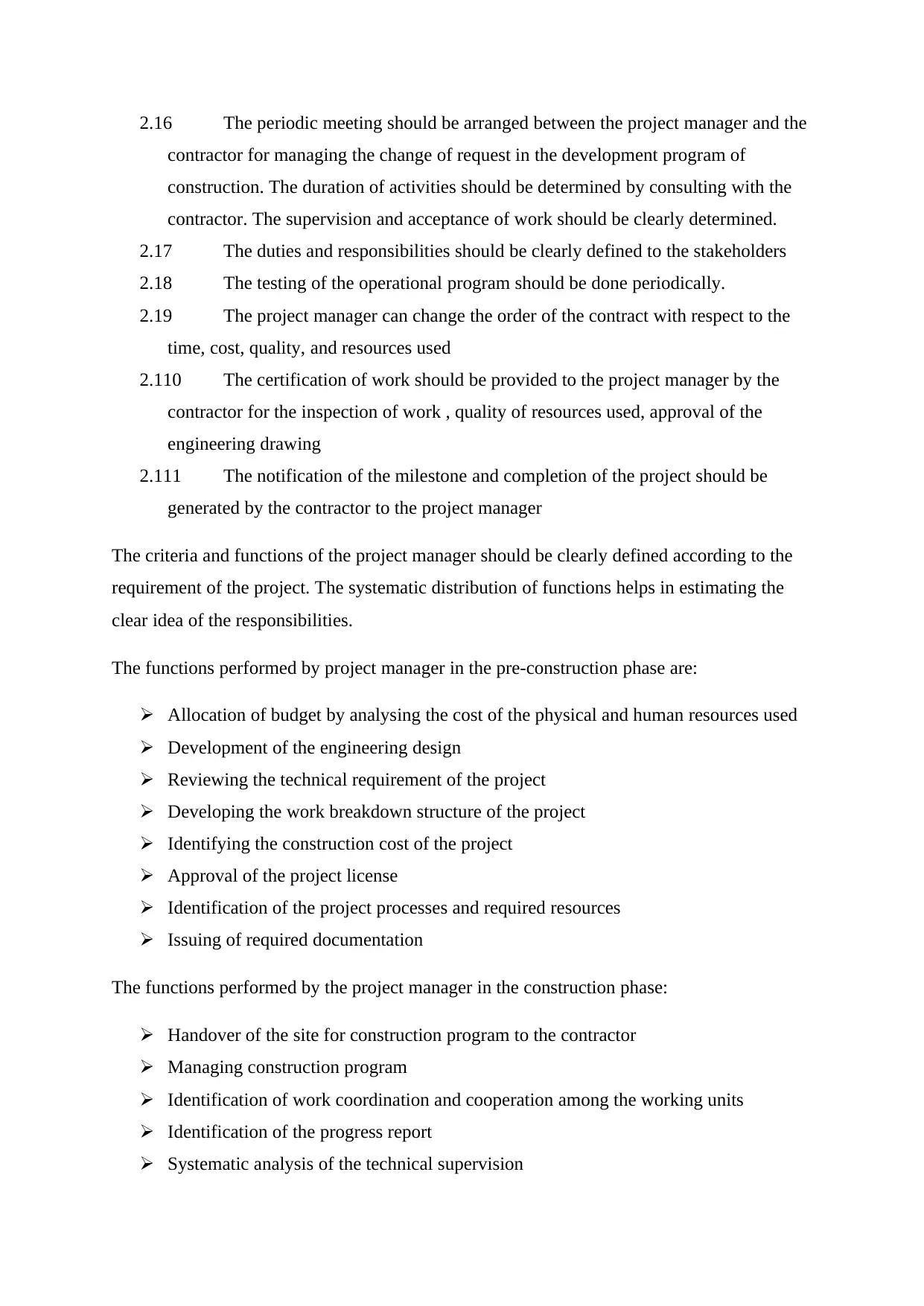
2.16 The periodic meeting should be arranged between the project manager and the
contractor for managing the change of request in the development program of
construction. The duration of activities should be determined by consulting with the
contractor. The supervision and acceptance of work should be clearly determined.
2.17 The duties and responsibilities should be clearly defined to the stakeholders
2.18 The testing of the operational program should be done periodically.
2.19 The project manager can change the order of the contract with respect to the
time, cost, quality, and resources used
2.110 The certification of work should be provided to the project manager by the
contractor for the inspection of work , quality of resources used, approval of the
engineering drawing
2.111 The notification of the milestone and completion of the project should be
generated by the contractor to the project manager
The criteria and functions of the project manager should be clearly defined according to the
requirement of the project. The systematic distribution of functions helps in estimating the
clear idea of the responsibilities.
The functions performed by project manager in the pre-construction phase are:
Allocation of budget by analysing the cost of the physical and human resources used
Development of the engineering design
Reviewing the technical requirement of the project
Developing the work breakdown structure of the project
Identifying the construction cost of the project
Approval of the project license
Identification of the project processes and required resources
Issuing of required documentation
The functions performed by the project manager in the construction phase:
Handover of the site for construction program to the contractor
Managing construction program
Identification of work coordination and cooperation among the working units
Identification of the progress report
Systematic analysis of the technical supervision
contractor for managing the change of request in the development program of
construction. The duration of activities should be determined by consulting with the
contractor. The supervision and acceptance of work should be clearly determined.
2.17 The duties and responsibilities should be clearly defined to the stakeholders
2.18 The testing of the operational program should be done periodically.
2.19 The project manager can change the order of the contract with respect to the
time, cost, quality, and resources used
2.110 The certification of work should be provided to the project manager by the
contractor for the inspection of work , quality of resources used, approval of the
engineering drawing
2.111 The notification of the milestone and completion of the project should be
generated by the contractor to the project manager
The criteria and functions of the project manager should be clearly defined according to the
requirement of the project. The systematic distribution of functions helps in estimating the
clear idea of the responsibilities.
The functions performed by project manager in the pre-construction phase are:
Allocation of budget by analysing the cost of the physical and human resources used
Development of the engineering design
Reviewing the technical requirement of the project
Developing the work breakdown structure of the project
Identifying the construction cost of the project
Approval of the project license
Identification of the project processes and required resources
Issuing of required documentation
The functions performed by the project manager in the construction phase:
Handover of the site for construction program to the contractor
Managing construction program
Identification of work coordination and cooperation among the working units
Identification of the progress report
Systematic analysis of the technical supervision
⊘ This is a preview!⊘
Do you want full access?
Subscribe today to unlock all pages.

Trusted by 1+ million students worldwide
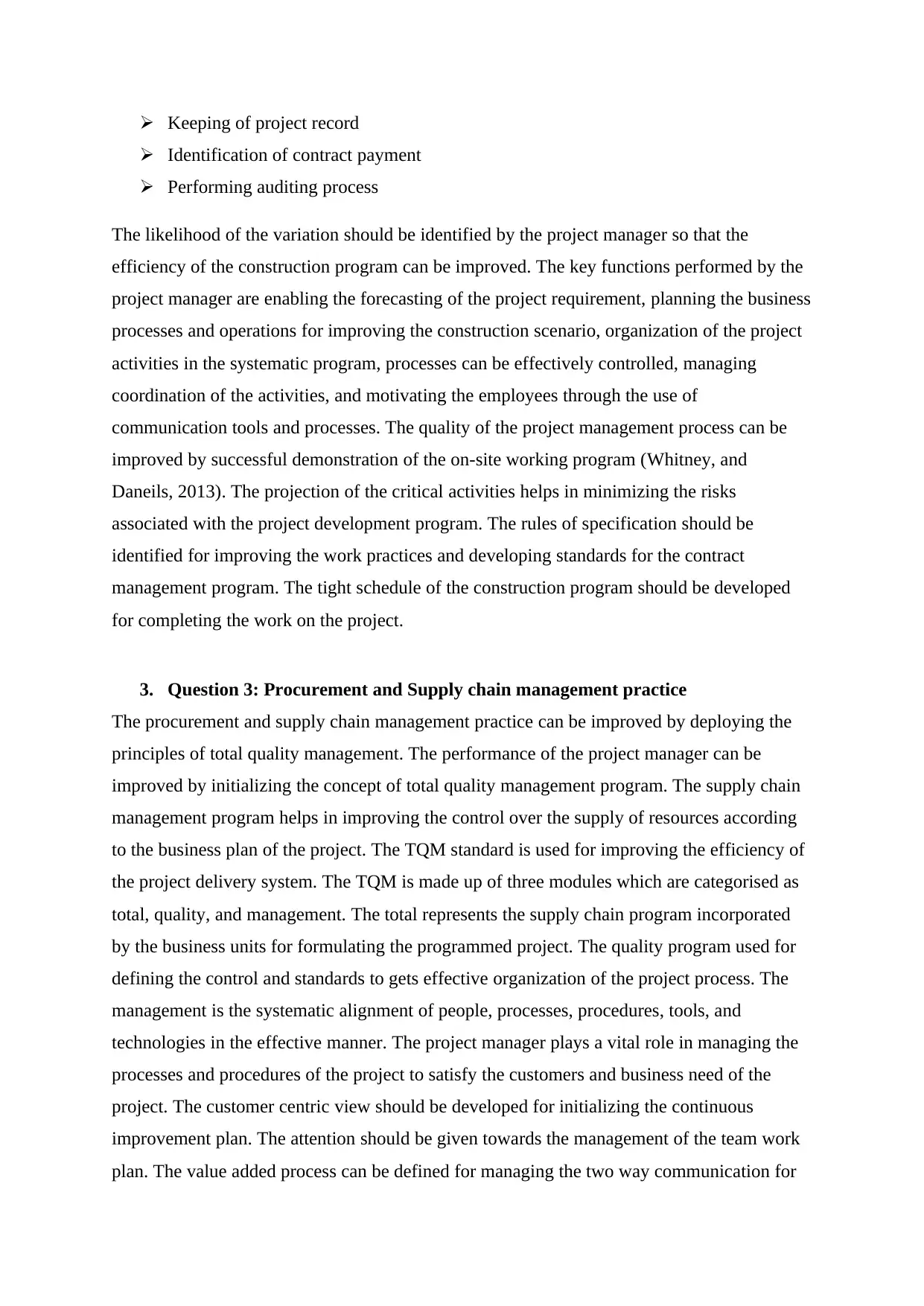
Keeping of project record
Identification of contract payment
Performing auditing process
The likelihood of the variation should be identified by the project manager so that the
efficiency of the construction program can be improved. The key functions performed by the
project manager are enabling the forecasting of the project requirement, planning the business
processes and operations for improving the construction scenario, organization of the project
activities in the systematic program, processes can be effectively controlled, managing
coordination of the activities, and motivating the employees through the use of
communication tools and processes. The quality of the project management process can be
improved by successful demonstration of the on-site working program (Whitney, and
Daneils, 2013). The projection of the critical activities helps in minimizing the risks
associated with the project development program. The rules of specification should be
identified for improving the work practices and developing standards for the contract
management program. The tight schedule of the construction program should be developed
for completing the work on the project.
3. Question 3: Procurement and Supply chain management practice
The procurement and supply chain management practice can be improved by deploying the
principles of total quality management. The performance of the project manager can be
improved by initializing the concept of total quality management program. The supply chain
management program helps in improving the control over the supply of resources according
to the business plan of the project. The TQM standard is used for improving the efficiency of
the project delivery system. The TQM is made up of three modules which are categorised as
total, quality, and management. The total represents the supply chain program incorporated
by the business units for formulating the programmed project. The quality program used for
defining the control and standards to gets effective organization of the project process. The
management is the systematic alignment of people, processes, procedures, tools, and
technologies in the effective manner. The project manager plays a vital role in managing the
processes and procedures of the project to satisfy the customers and business need of the
project. The customer centric view should be developed for initializing the continuous
improvement plan. The attention should be given towards the management of the team work
plan. The value added process can be defined for managing the two way communication for
Identification of contract payment
Performing auditing process
The likelihood of the variation should be identified by the project manager so that the
efficiency of the construction program can be improved. The key functions performed by the
project manager are enabling the forecasting of the project requirement, planning the business
processes and operations for improving the construction scenario, organization of the project
activities in the systematic program, processes can be effectively controlled, managing
coordination of the activities, and motivating the employees through the use of
communication tools and processes. The quality of the project management process can be
improved by successful demonstration of the on-site working program (Whitney, and
Daneils, 2013). The projection of the critical activities helps in minimizing the risks
associated with the project development program. The rules of specification should be
identified for improving the work practices and developing standards for the contract
management program. The tight schedule of the construction program should be developed
for completing the work on the project.
3. Question 3: Procurement and Supply chain management practice
The procurement and supply chain management practice can be improved by deploying the
principles of total quality management. The performance of the project manager can be
improved by initializing the concept of total quality management program. The supply chain
management program helps in improving the control over the supply of resources according
to the business plan of the project. The TQM standard is used for improving the efficiency of
the project delivery system. The TQM is made up of three modules which are categorised as
total, quality, and management. The total represents the supply chain program incorporated
by the business units for formulating the programmed project. The quality program used for
defining the control and standards to gets effective organization of the project process. The
management is the systematic alignment of people, processes, procedures, tools, and
technologies in the effective manner. The project manager plays a vital role in managing the
processes and procedures of the project to satisfy the customers and business need of the
project. The customer centric view should be developed for initializing the continuous
improvement plan. The attention should be given towards the management of the team work
plan. The value added process can be defined for managing the two way communication for
Paraphrase This Document
Need a fresh take? Get an instant paraphrase of this document with our AI Paraphraser
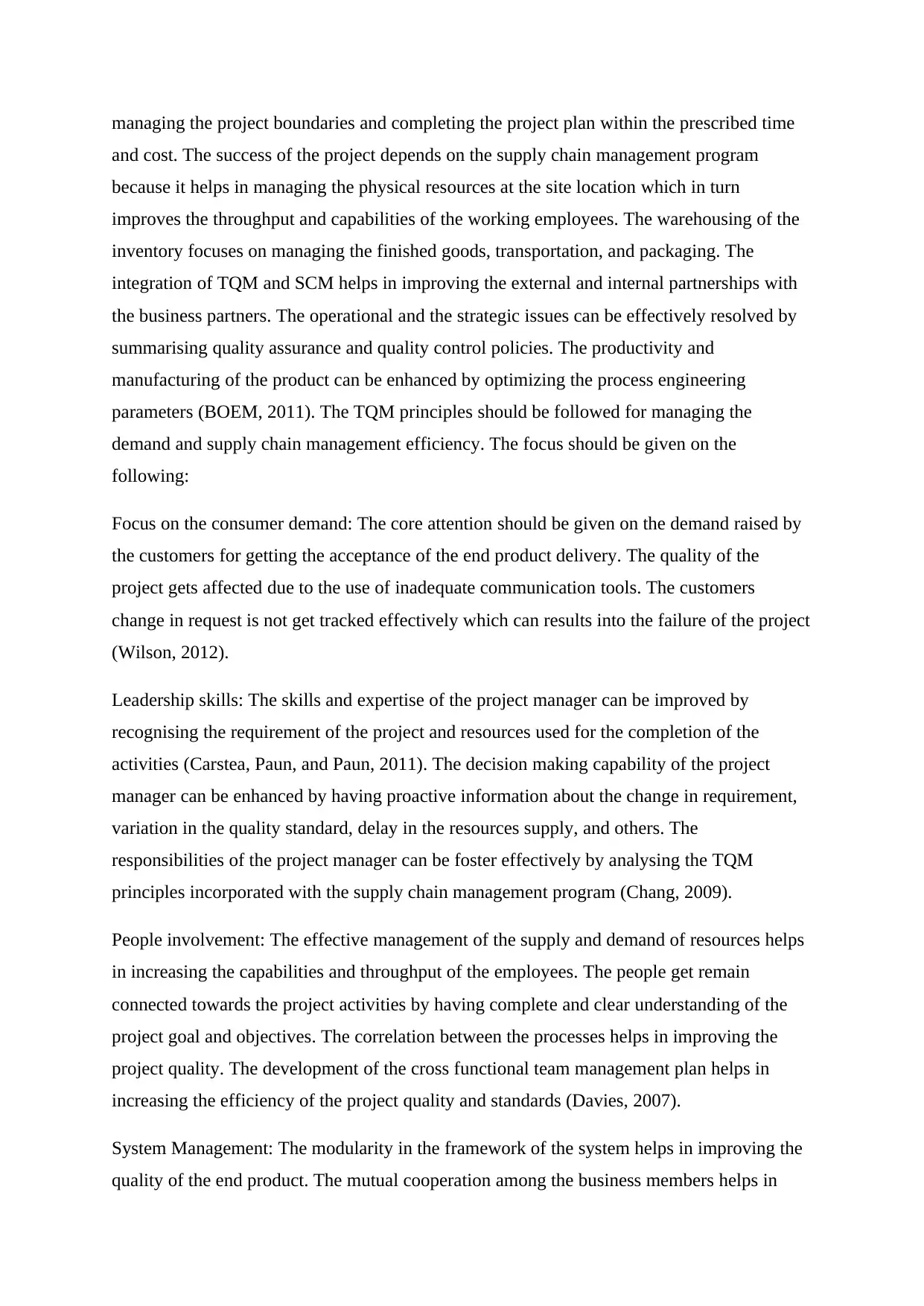
managing the project boundaries and completing the project plan within the prescribed time
and cost. The success of the project depends on the supply chain management program
because it helps in managing the physical resources at the site location which in turn
improves the throughput and capabilities of the working employees. The warehousing of the
inventory focuses on managing the finished goods, transportation, and packaging. The
integration of TQM and SCM helps in improving the external and internal partnerships with
the business partners. The operational and the strategic issues can be effectively resolved by
summarising quality assurance and quality control policies. The productivity and
manufacturing of the product can be enhanced by optimizing the process engineering
parameters (BOEM, 2011). The TQM principles should be followed for managing the
demand and supply chain management efficiency. The focus should be given on the
following:
Focus on the consumer demand: The core attention should be given on the demand raised by
the customers for getting the acceptance of the end product delivery. The quality of the
project gets affected due to the use of inadequate communication tools. The customers
change in request is not get tracked effectively which can results into the failure of the project
(Wilson, 2012).
Leadership skills: The skills and expertise of the project manager can be improved by
recognising the requirement of the project and resources used for the completion of the
activities (Carstea, Paun, and Paun, 2011). The decision making capability of the project
manager can be enhanced by having proactive information about the change in requirement,
variation in the quality standard, delay in the resources supply, and others. The
responsibilities of the project manager can be foster effectively by analysing the TQM
principles incorporated with the supply chain management program (Chang, 2009).
People involvement: The effective management of the supply and demand of resources helps
in increasing the capabilities and throughput of the employees. The people get remain
connected towards the project activities by having complete and clear understanding of the
project goal and objectives. The correlation between the processes helps in improving the
project quality. The development of the cross functional team management plan helps in
increasing the efficiency of the project quality and standards (Davies, 2007).
System Management: The modularity in the framework of the system helps in improving the
quality of the end product. The mutual cooperation among the business members helps in
and cost. The success of the project depends on the supply chain management program
because it helps in managing the physical resources at the site location which in turn
improves the throughput and capabilities of the working employees. The warehousing of the
inventory focuses on managing the finished goods, transportation, and packaging. The
integration of TQM and SCM helps in improving the external and internal partnerships with
the business partners. The operational and the strategic issues can be effectively resolved by
summarising quality assurance and quality control policies. The productivity and
manufacturing of the product can be enhanced by optimizing the process engineering
parameters (BOEM, 2011). The TQM principles should be followed for managing the
demand and supply chain management efficiency. The focus should be given on the
following:
Focus on the consumer demand: The core attention should be given on the demand raised by
the customers for getting the acceptance of the end product delivery. The quality of the
project gets affected due to the use of inadequate communication tools. The customers
change in request is not get tracked effectively which can results into the failure of the project
(Wilson, 2012).
Leadership skills: The skills and expertise of the project manager can be improved by
recognising the requirement of the project and resources used for the completion of the
activities (Carstea, Paun, and Paun, 2011). The decision making capability of the project
manager can be enhanced by having proactive information about the change in requirement,
variation in the quality standard, delay in the resources supply, and others. The
responsibilities of the project manager can be foster effectively by analysing the TQM
principles incorporated with the supply chain management program (Chang, 2009).
People involvement: The effective management of the supply and demand of resources helps
in increasing the capabilities and throughput of the employees. The people get remain
connected towards the project activities by having complete and clear understanding of the
project goal and objectives. The correlation between the processes helps in improving the
project quality. The development of the cross functional team management plan helps in
increasing the efficiency of the project quality and standards (Davies, 2007).
System Management: The modularity in the framework of the system helps in improving the
quality of the end product. The mutual cooperation among the business members helps in
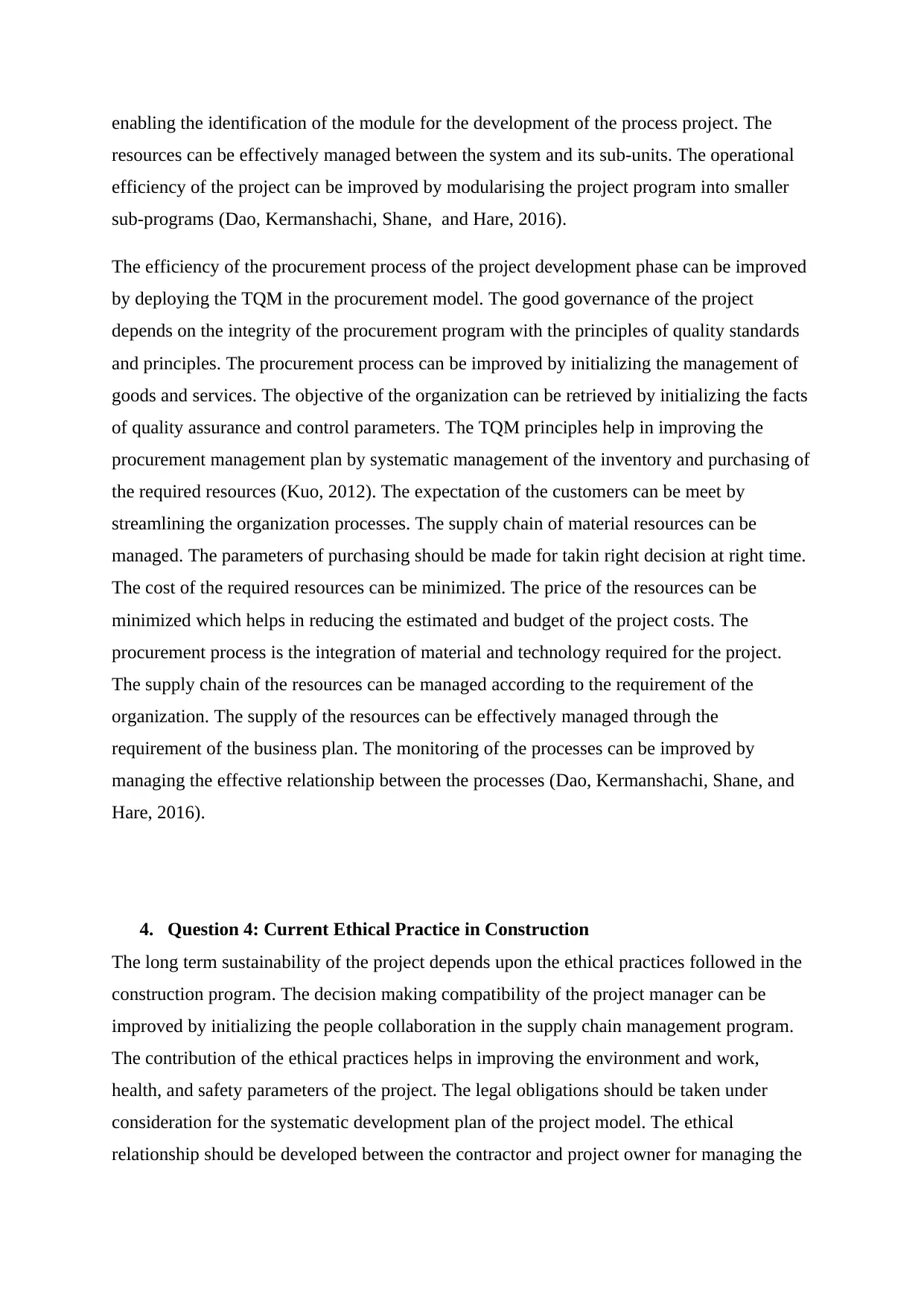
enabling the identification of the module for the development of the process project. The
resources can be effectively managed between the system and its sub-units. The operational
efficiency of the project can be improved by modularising the project program into smaller
sub-programs (Dao, Kermanshachi, Shane, and Hare, 2016).
The efficiency of the procurement process of the project development phase can be improved
by deploying the TQM in the procurement model. The good governance of the project
depends on the integrity of the procurement program with the principles of quality standards
and principles. The procurement process can be improved by initializing the management of
goods and services. The objective of the organization can be retrieved by initializing the facts
of quality assurance and control parameters. The TQM principles help in improving the
procurement management plan by systematic management of the inventory and purchasing of
the required resources (Kuo, 2012). The expectation of the customers can be meet by
streamlining the organization processes. The supply chain of material resources can be
managed. The parameters of purchasing should be made for takin right decision at right time.
The cost of the required resources can be minimized. The price of the resources can be
minimized which helps in reducing the estimated and budget of the project costs. The
procurement process is the integration of material and technology required for the project.
The supply chain of the resources can be managed according to the requirement of the
organization. The supply of the resources can be effectively managed through the
requirement of the business plan. The monitoring of the processes can be improved by
managing the effective relationship between the processes (Dao, Kermanshachi, Shane, and
Hare, 2016).
4. Question 4: Current Ethical Practice in Construction
The long term sustainability of the project depends upon the ethical practices followed in the
construction program. The decision making compatibility of the project manager can be
improved by initializing the people collaboration in the supply chain management program.
The contribution of the ethical practices helps in improving the environment and work,
health, and safety parameters of the project. The legal obligations should be taken under
consideration for the systematic development plan of the project model. The ethical
relationship should be developed between the contractor and project owner for managing the
resources can be effectively managed between the system and its sub-units. The operational
efficiency of the project can be improved by modularising the project program into smaller
sub-programs (Dao, Kermanshachi, Shane, and Hare, 2016).
The efficiency of the procurement process of the project development phase can be improved
by deploying the TQM in the procurement model. The good governance of the project
depends on the integrity of the procurement program with the principles of quality standards
and principles. The procurement process can be improved by initializing the management of
goods and services. The objective of the organization can be retrieved by initializing the facts
of quality assurance and control parameters. The TQM principles help in improving the
procurement management plan by systematic management of the inventory and purchasing of
the required resources (Kuo, 2012). The expectation of the customers can be meet by
streamlining the organization processes. The supply chain of material resources can be
managed. The parameters of purchasing should be made for takin right decision at right time.
The cost of the required resources can be minimized. The price of the resources can be
minimized which helps in reducing the estimated and budget of the project costs. The
procurement process is the integration of material and technology required for the project.
The supply chain of the resources can be managed according to the requirement of the
organization. The supply of the resources can be effectively managed through the
requirement of the business plan. The monitoring of the processes can be improved by
managing the effective relationship between the processes (Dao, Kermanshachi, Shane, and
Hare, 2016).
4. Question 4: Current Ethical Practice in Construction
The long term sustainability of the project depends upon the ethical practices followed in the
construction program. The decision making compatibility of the project manager can be
improved by initializing the people collaboration in the supply chain management program.
The contribution of the ethical practices helps in improving the environment and work,
health, and safety parameters of the project. The legal obligations should be taken under
consideration for the systematic development plan of the project model. The ethical
relationship should be developed between the contractor and project owner for managing the
⊘ This is a preview!⊘
Do you want full access?
Subscribe today to unlock all pages.

Trusted by 1+ million students worldwide
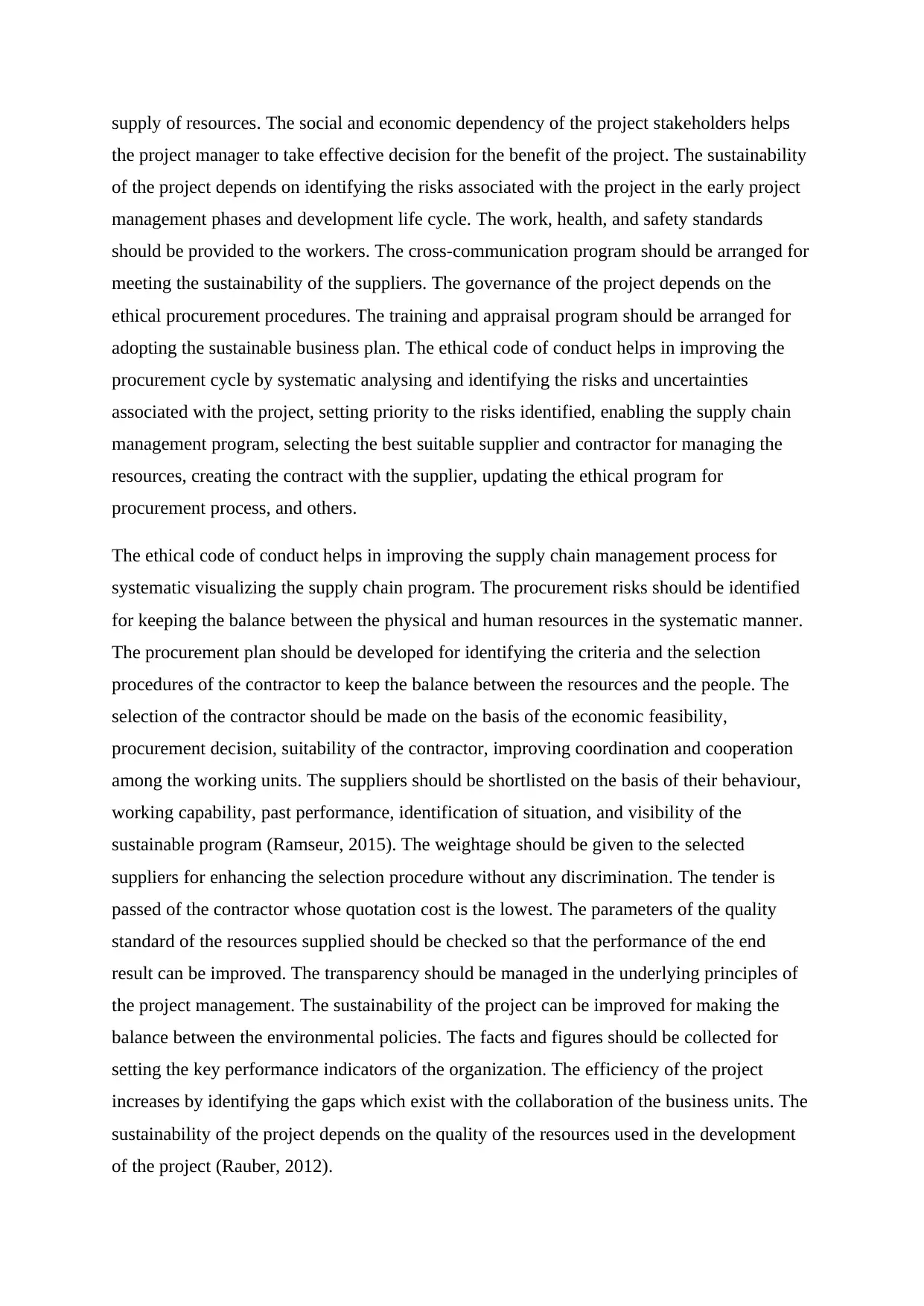
supply of resources. The social and economic dependency of the project stakeholders helps
the project manager to take effective decision for the benefit of the project. The sustainability
of the project depends on identifying the risks associated with the project in the early project
management phases and development life cycle. The work, health, and safety standards
should be provided to the workers. The cross-communication program should be arranged for
meeting the sustainability of the suppliers. The governance of the project depends on the
ethical procurement procedures. The training and appraisal program should be arranged for
adopting the sustainable business plan. The ethical code of conduct helps in improving the
procurement cycle by systematic analysing and identifying the risks and uncertainties
associated with the project, setting priority to the risks identified, enabling the supply chain
management program, selecting the best suitable supplier and contractor for managing the
resources, creating the contract with the supplier, updating the ethical program for
procurement process, and others.
The ethical code of conduct helps in improving the supply chain management process for
systematic visualizing the supply chain program. The procurement risks should be identified
for keeping the balance between the physical and human resources in the systematic manner.
The procurement plan should be developed for identifying the criteria and the selection
procedures of the contractor to keep the balance between the resources and the people. The
selection of the contractor should be made on the basis of the economic feasibility,
procurement decision, suitability of the contractor, improving coordination and cooperation
among the working units. The suppliers should be shortlisted on the basis of their behaviour,
working capability, past performance, identification of situation, and visibility of the
sustainable program (Ramseur, 2015). The weightage should be given to the selected
suppliers for enhancing the selection procedure without any discrimination. The tender is
passed of the contractor whose quotation cost is the lowest. The parameters of the quality
standard of the resources supplied should be checked so that the performance of the end
result can be improved. The transparency should be managed in the underlying principles of
the project management. The sustainability of the project can be improved for making the
balance between the environmental policies. The facts and figures should be collected for
setting the key performance indicators of the organization. The efficiency of the project
increases by identifying the gaps which exist with the collaboration of the business units. The
sustainability of the project depends on the quality of the resources used in the development
of the project (Rauber, 2012).
the project manager to take effective decision for the benefit of the project. The sustainability
of the project depends on identifying the risks associated with the project in the early project
management phases and development life cycle. The work, health, and safety standards
should be provided to the workers. The cross-communication program should be arranged for
meeting the sustainability of the suppliers. The governance of the project depends on the
ethical procurement procedures. The training and appraisal program should be arranged for
adopting the sustainable business plan. The ethical code of conduct helps in improving the
procurement cycle by systematic analysing and identifying the risks and uncertainties
associated with the project, setting priority to the risks identified, enabling the supply chain
management program, selecting the best suitable supplier and contractor for managing the
resources, creating the contract with the supplier, updating the ethical program for
procurement process, and others.
The ethical code of conduct helps in improving the supply chain management process for
systematic visualizing the supply chain program. The procurement risks should be identified
for keeping the balance between the physical and human resources in the systematic manner.
The procurement plan should be developed for identifying the criteria and the selection
procedures of the contractor to keep the balance between the resources and the people. The
selection of the contractor should be made on the basis of the economic feasibility,
procurement decision, suitability of the contractor, improving coordination and cooperation
among the working units. The suppliers should be shortlisted on the basis of their behaviour,
working capability, past performance, identification of situation, and visibility of the
sustainable program (Ramseur, 2015). The weightage should be given to the selected
suppliers for enhancing the selection procedure without any discrimination. The tender is
passed of the contractor whose quotation cost is the lowest. The parameters of the quality
standard of the resources supplied should be checked so that the performance of the end
result can be improved. The transparency should be managed in the underlying principles of
the project management. The sustainability of the project can be improved for making the
balance between the environmental policies. The facts and figures should be collected for
setting the key performance indicators of the organization. The efficiency of the project
increases by identifying the gaps which exist with the collaboration of the business units. The
sustainability of the project depends on the quality of the resources used in the development
of the project (Rauber, 2012).
Paraphrase This Document
Need a fresh take? Get an instant paraphrase of this document with our AI Paraphraser
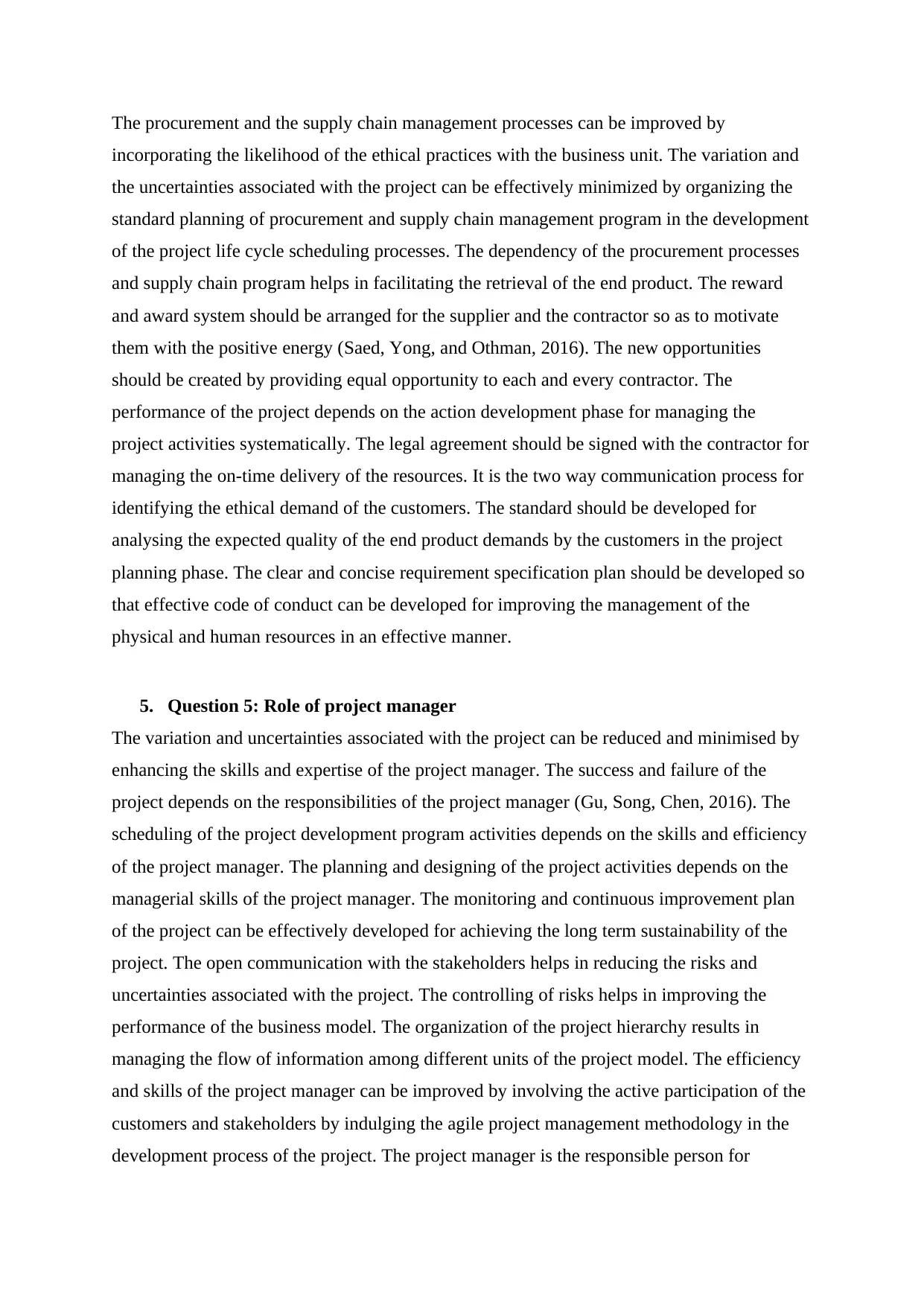
The procurement and the supply chain management processes can be improved by
incorporating the likelihood of the ethical practices with the business unit. The variation and
the uncertainties associated with the project can be effectively minimized by organizing the
standard planning of procurement and supply chain management program in the development
of the project life cycle scheduling processes. The dependency of the procurement processes
and supply chain program helps in facilitating the retrieval of the end product. The reward
and award system should be arranged for the supplier and the contractor so as to motivate
them with the positive energy (Saed, Yong, and Othman, 2016). The new opportunities
should be created by providing equal opportunity to each and every contractor. The
performance of the project depends on the action development phase for managing the
project activities systematically. The legal agreement should be signed with the contractor for
managing the on-time delivery of the resources. It is the two way communication process for
identifying the ethical demand of the customers. The standard should be developed for
analysing the expected quality of the end product demands by the customers in the project
planning phase. The clear and concise requirement specification plan should be developed so
that effective code of conduct can be developed for improving the management of the
physical and human resources in an effective manner.
5. Question 5: Role of project manager
The variation and uncertainties associated with the project can be reduced and minimised by
enhancing the skills and expertise of the project manager. The success and failure of the
project depends on the responsibilities of the project manager (Gu, Song, Chen, 2016). The
scheduling of the project development program activities depends on the skills and efficiency
of the project manager. The planning and designing of the project activities depends on the
managerial skills of the project manager. The monitoring and continuous improvement plan
of the project can be effectively developed for achieving the long term sustainability of the
project. The open communication with the stakeholders helps in reducing the risks and
uncertainties associated with the project. The controlling of risks helps in improving the
performance of the business model. The organization of the project hierarchy results in
managing the flow of information among different units of the project model. The efficiency
and skills of the project manager can be improved by involving the active participation of the
customers and stakeholders by indulging the agile project management methodology in the
development process of the project. The project manager is the responsible person for
incorporating the likelihood of the ethical practices with the business unit. The variation and
the uncertainties associated with the project can be effectively minimized by organizing the
standard planning of procurement and supply chain management program in the development
of the project life cycle scheduling processes. The dependency of the procurement processes
and supply chain program helps in facilitating the retrieval of the end product. The reward
and award system should be arranged for the supplier and the contractor so as to motivate
them with the positive energy (Saed, Yong, and Othman, 2016). The new opportunities
should be created by providing equal opportunity to each and every contractor. The
performance of the project depends on the action development phase for managing the
project activities systematically. The legal agreement should be signed with the contractor for
managing the on-time delivery of the resources. It is the two way communication process for
identifying the ethical demand of the customers. The standard should be developed for
analysing the expected quality of the end product demands by the customers in the project
planning phase. The clear and concise requirement specification plan should be developed so
that effective code of conduct can be developed for improving the management of the
physical and human resources in an effective manner.
5. Question 5: Role of project manager
The variation and uncertainties associated with the project can be reduced and minimised by
enhancing the skills and expertise of the project manager. The success and failure of the
project depends on the responsibilities of the project manager (Gu, Song, Chen, 2016). The
scheduling of the project development program activities depends on the skills and efficiency
of the project manager. The planning and designing of the project activities depends on the
managerial skills of the project manager. The monitoring and continuous improvement plan
of the project can be effectively developed for achieving the long term sustainability of the
project. The open communication with the stakeholders helps in reducing the risks and
uncertainties associated with the project. The controlling of risks helps in improving the
performance of the business model. The organization of the project hierarchy results in
managing the flow of information among different units of the project model. The efficiency
and skills of the project manager can be improved by involving the active participation of the
customers and stakeholders by indulging the agile project management methodology in the
development process of the project. The project manager is the responsible person for
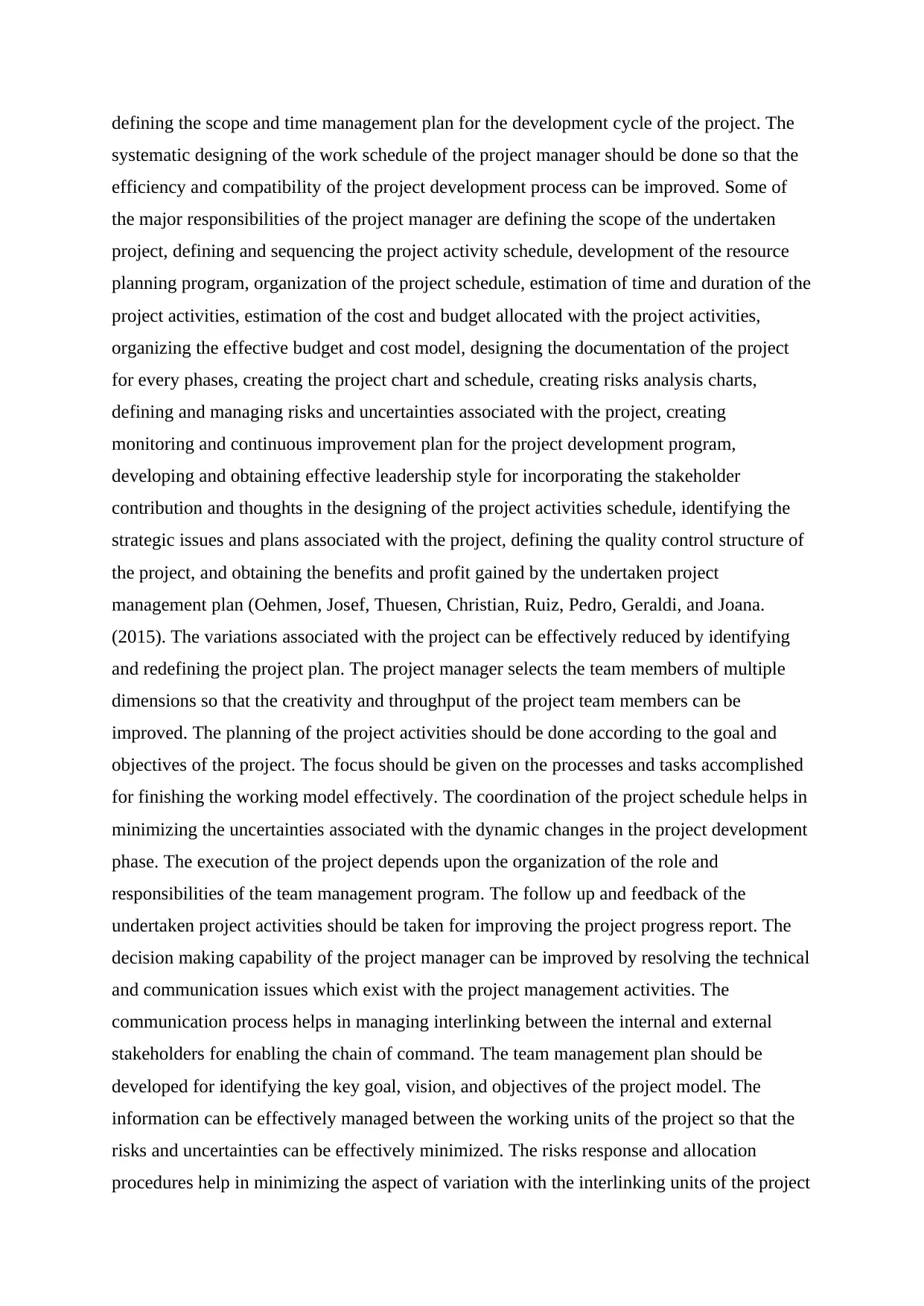
defining the scope and time management plan for the development cycle of the project. The
systematic designing of the work schedule of the project manager should be done so that the
efficiency and compatibility of the project development process can be improved. Some of
the major responsibilities of the project manager are defining the scope of the undertaken
project, defining and sequencing the project activity schedule, development of the resource
planning program, organization of the project schedule, estimation of time and duration of the
project activities, estimation of the cost and budget allocated with the project activities,
organizing the effective budget and cost model, designing the documentation of the project
for every phases, creating the project chart and schedule, creating risks analysis charts,
defining and managing risks and uncertainties associated with the project, creating
monitoring and continuous improvement plan for the project development program,
developing and obtaining effective leadership style for incorporating the stakeholder
contribution and thoughts in the designing of the project activities schedule, identifying the
strategic issues and plans associated with the project, defining the quality control structure of
the project, and obtaining the benefits and profit gained by the undertaken project
management plan (Oehmen, Josef, Thuesen, Christian, Ruiz, Pedro, Geraldi, and Joana.
(2015). The variations associated with the project can be effectively reduced by identifying
and redefining the project plan. The project manager selects the team members of multiple
dimensions so that the creativity and throughput of the project team members can be
improved. The planning of the project activities should be done according to the goal and
objectives of the project. The focus should be given on the processes and tasks accomplished
for finishing the working model effectively. The coordination of the project schedule helps in
minimizing the uncertainties associated with the dynamic changes in the project development
phase. The execution of the project depends upon the organization of the role and
responsibilities of the team management program. The follow up and feedback of the
undertaken project activities should be taken for improving the project progress report. The
decision making capability of the project manager can be improved by resolving the technical
and communication issues which exist with the project management activities. The
communication process helps in managing interlinking between the internal and external
stakeholders for enabling the chain of command. The team management plan should be
developed for identifying the key goal, vision, and objectives of the project model. The
information can be effectively managed between the working units of the project so that the
risks and uncertainties can be effectively minimized. The risks response and allocation
procedures help in minimizing the aspect of variation with the interlinking units of the project
systematic designing of the work schedule of the project manager should be done so that the
efficiency and compatibility of the project development process can be improved. Some of
the major responsibilities of the project manager are defining the scope of the undertaken
project, defining and sequencing the project activity schedule, development of the resource
planning program, organization of the project schedule, estimation of time and duration of the
project activities, estimation of the cost and budget allocated with the project activities,
organizing the effective budget and cost model, designing the documentation of the project
for every phases, creating the project chart and schedule, creating risks analysis charts,
defining and managing risks and uncertainties associated with the project, creating
monitoring and continuous improvement plan for the project development program,
developing and obtaining effective leadership style for incorporating the stakeholder
contribution and thoughts in the designing of the project activities schedule, identifying the
strategic issues and plans associated with the project, defining the quality control structure of
the project, and obtaining the benefits and profit gained by the undertaken project
management plan (Oehmen, Josef, Thuesen, Christian, Ruiz, Pedro, Geraldi, and Joana.
(2015). The variations associated with the project can be effectively reduced by identifying
and redefining the project plan. The project manager selects the team members of multiple
dimensions so that the creativity and throughput of the project team members can be
improved. The planning of the project activities should be done according to the goal and
objectives of the project. The focus should be given on the processes and tasks accomplished
for finishing the working model effectively. The coordination of the project schedule helps in
minimizing the uncertainties associated with the dynamic changes in the project development
phase. The execution of the project depends upon the organization of the role and
responsibilities of the team management program. The follow up and feedback of the
undertaken project activities should be taken for improving the project progress report. The
decision making capability of the project manager can be improved by resolving the technical
and communication issues which exist with the project management activities. The
communication process helps in managing interlinking between the internal and external
stakeholders for enabling the chain of command. The team management plan should be
developed for identifying the key goal, vision, and objectives of the project model. The
information can be effectively managed between the working units of the project so that the
risks and uncertainties can be effectively minimized. The risks response and allocation
procedures help in minimizing the aspect of variation with the interlinking units of the project
⊘ This is a preview!⊘
Do you want full access?
Subscribe today to unlock all pages.

Trusted by 1+ million students worldwide
1 out of 17
Related Documents
Your All-in-One AI-Powered Toolkit for Academic Success.
+13062052269
info@desklib.com
Available 24*7 on WhatsApp / Email
![[object Object]](/_next/static/media/star-bottom.7253800d.svg)
Unlock your academic potential
Copyright © 2020–2025 A2Z Services. All Rights Reserved. Developed and managed by ZUCOL.




